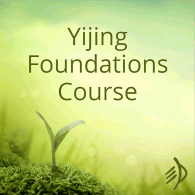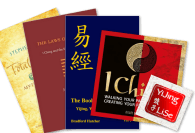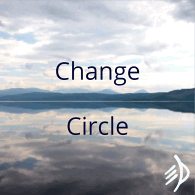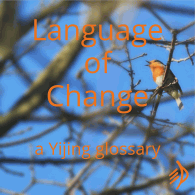The muddle
If you’re new to the I Ching, you could be forgiven for wondering why there are apparently two hexagrams called ‘Obstruction’: Hexagram 12 (according to such translators as Cleary and Richter) and Hexagram 39 (according to Balkin, amongst others). Neither hexagram is one you’d generally rejoice to see in a reading – both indicate that whatever you’re asking about is going to be tough. You won’t be able to make the kind of progress you’d hoped for; circumstances are not in your favour; this is going to be anything but smooth sailing.
So what’s the difference?
The names of the hexagrams
Hexagram 12 is called pi 否, which the dictionary tells us means…
- No.
- To deny or refuse to do.
- To go against (specifically, to go against the will of Heaven).
- Bad, wrong.
The ancient Chinese character shows a mouth and probably a plant that is cut off at soil level. If you take a sharp hoe to the weeds often enough, they will eventually give up and stop growing.
Hexagram 39 is called jian 蹇. Its definitions include…
- Lame, limping, difficulty walking, weakness in the legs.
- Stuttering, difficulty speaking.
- Slow, painful, difficult.
- Worn out.
This is a more complex character – you can read LiSe’s account of it here. But it definitely includes the component for foot, pointing to the early meaning of lame and limping.
So you can see that while you might experience both of these as running into an obstruction, the underlying picture – the reason why it isn’t working, and what you could do about this – is quite different. You might say that Hexagram 12 is saying “no” while Hexagram 39 is saying “not that way“.
The Oracles
‘Blocking it, non-people.
Noble one’s constancy bears no fruit.
Great goes, small comes.’
‘Limping. Fruitful in the west and south,
Not fruitful in the east and north.
Fruitful to see great people.
Constancy, good fortune.’
Interestingly, both of these oracles are based on a contrast – but that’s where the resemblance ends. Hexagram 39 draws a contrast between two directions. One bears fruit, the other does not. Whether you interpret this on the basis of the bagua (which arranges the trigrams around the points of the compass) and reflect on the qualities of Lake and Fire, or refer to Zhou history and think of seeking allies, the advice is basically this way, not that way. There is a direction that will bear fruit. And so too will seeing great people, and hence getting the benefits of longer vision and better understanding.
But in Hexagram 12, when you are blocked, the picture is very different. No amount of imagination or persistence is going to bring any reward at all. The contrast is between two kinds of people – the non-people and the noble one – and between great and small. That means both ways of being, the active and creative versus the merely adaptive, and also the scale of creative action which is possible. This is just not a time when you can do great things.
(I also have an idea – thanks to Scott Davies and David Pankenier – that Hexagram 12 may be associated with the moment when the Zhou and their allies were gathered ready to cross the river and march on Shang, but turned back because the movement of Jupiter went against them. In other words, your ideas are absolutely out of harmony with the time.)
Images
The contrasting trigram pictures of the two hexagrams make the difference between them very easy to see. In Hexagram 39, there is water above the mountain. You can imagine battling your way up the slopes through torrential rain, with the loose scree starting to slide away under your feet. (And you might also take a message from the water, which will not be trying to flow uphill.) In Hexagram 12, there is simply the earth below heaven. You are standing on the empty plain, staring up at a receding, unheeding sky.
It was the trigram picture that made Bradford Hatcher so unimpressed with ‘obstruction’ as a translation for Hexagram 12:
“Obstruction is a poor choice of names in this context, even without the confusion with Gua 39. It may be a valid gloss for the word Pǐ (also pronounced Fǒu) in its broader usage in the language, but its use here betrays a misunderstanding of the forces at work in this Gua. These forces are moving in different directions, away from each other, not in opposition or confrontation.”
From https://www.hermetica.info/GuaMing.htm which is not just a list of hexagram names.
The Image text gives you the best advice on how to respond to the situation in general:
‘Above the mountain, there is water. Limping.
Noble one turns himself around to renew his character.’
‘Heaven and earth do not interact. Blocked.
A noble one uses her strength sparingly to avoid hardship.
She does not allow herself honours and payment.’
In Hexagram 39, you should turn yourself around. If at first you don’t succeed, try something different. In Hexagram 12, not only should you stop banging your head against this wall, but also be aware that if you are gaining in this situation, something is wrong.
Imaginary readings
Suppose you asked, ‘What about trying this?’ and received Hexagram 39 unchanging. Then you would know it was going to be very hard. You might want to stop and rethink, find help, take advice and look for an easier way.
If you asked “What about trying this? and received Hexagram 12 unchanging, then you would know it wouldn’t work.
Or, suppose you asked, “How can I move forward in this relationship?” Then, Hexagram 39 might encourage you to seek out a good counsellor to find a new approach. And Hexagram 12 might sound like Yi asking, “What relationship?”
Hexagram 12, though, is a hexagram whose meaning is really multiplied by being unchanging: nothing is happening to nothing happening. Things would be different with lines changing. When it’s changing, I find Hexagram 12 becomes ‘Dealing with the Block’ in the same way that 18 becomes ‘Dealing with Corruption’. That could mean acceptance or complete transformation – changing the message of the reading.
A line by line comparison is beyond the scope of this post (or this brain), but we could try looking at how each hexagram works with the same relating hexagram.
Hexagram 25, for instance, Without Entanglement. As I mentioned before, when 39 changes to 25, all its lines about going on versus coming back are active. I think this makes intuitive sense: the disengaging and disentangling of Limping involves turning round and coming back, not ignoring the difficulties and forging ahead regardless. You don’t need to struggle on up the mountain, says Hexagram 25; there is no real reason to do that.
Hexagram 12 is just one line away from 25:
‘Pulling up thatch grass, roots entangled,
12.1
With more of its kind.
Constancy, good fortune. Creating success.’
Here I think the wisdom of 25 means finding the best point to apply energy – where things are subtly connected, even if this isn’t apparent on the surface, and change will naturally beget change.
One more example: suppose our hexagrams are changing to 8, Seeking Union or Belonging. With 39, that’s a single line change:
‘Going on, limping; coming back, turnaround.’
39.3
Choose your people, find where you belong, follow your natural affinities, and this is already turning you around and leading you back home.
Hexagram 12 changes to 8 through lines 4 and 6:
‘There is a mandate, no mistake.
12.4.6
Work with clarity, fulfilment.’
‘Overturning the block.
Before, blocked. Afterwards, rejoicing.’
The sense of belonging works a complete transformation in 12, perhaps because it is all about what you say yes to. There is the call, and light, and the end of the Block.










This is a terrific analysis, thank you.
Thank You, Right On Time for Me.
I’m really glad this is helpful! Are there any other pairs/ groups of hexagrams that can be hard to differentiate?
Struggling to find an interpretation for a reading today, and this is exactly what I needed. Thank you!